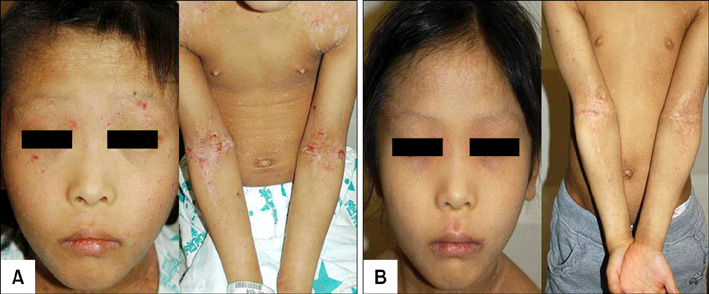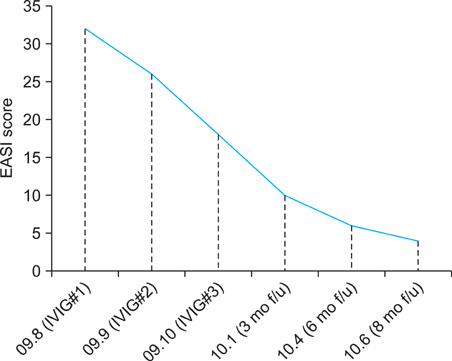Ann Dermatol.
2012 Feb;24(1):66-69. 10.5021/ad.2012.24.1.66.
Intravenous Immunoglobulin Treatment in a Child with Resistant Atopic Dermatitis
- Affiliations
-
- 1Department of Dermatology, Seoul National University College of Medicine, Seoul, Korea. kyuhkim@snu.ac.kr
- KMID: 2156858
- DOI: http://doi.org/10.5021/ad.2012.24.1.66
Abstract
- In a subgroup of patients suffering from atopic dermatitis (AD), treatment is quite difficult even after taking oral immunosuppressants. High-dose intravenous immunoglobulin (IVIG) treatment has been reported to be beneficial for them in a few uncontrolled trials. Herein we report a case of intractable AD in a 5-year-old girl who had significant clinical improvement after receiving 3 cycles of IVIG treatment (2 g/kg) without notable side effects. Since the first infusion of IVIG, the patient's skin lesions improved steadily and the improvement persisted until the 8-month follow-up. The eczema area and severity index score decreased remarkably, while immunologic parameters did not correlate with clinical improvement. This case suggests that IVIG therapy can be quite effective and safe for children with resistant AD.
MeSH Terms
Figure
Cited by 1 articles
-
Overview of atopic dermatitis
Kyu Han Kim
Asia Pac Allergy. 2013;3(2):79-87. doi: 10.5415/apallergy.2013.3.2.79.
Reference
-
1. Williams HC. Clinical practice. Atopic dermatitis. N Engl J Med. 2005. 352:2314–2324.2. Williams HC, Wüthrich B. Williams HC, editor. The natural history of atopic dermatitis. Atopic dermatitis: the epidemiology, causes, and prevention of atopic eczema. 2000. Cambridge, United Kingdom: Cambridge University Press;41–59.
Article3. Grundmann-Kollmann M, Podda M, Ochsendorf F, Boehncke WH, Kaufmann R, Zollner TM. Mycophenolate mofetil is effective in the treatment of atopic dermatitis. Arch Dermatol. 2001. 137:870–873.4. Jang IG, Yang JK, Lee HJ, Yi JY, Kim HO, Kim CW, et al. Clinical improvement and immunohistochemical findings in severe atopic dermatitis treated with interferon gamma. J Am Acad Dermatol. 2000. 42:1033–1040.
Article5. Jacobi A, Antoni C, Manger B, Schuler G, Hertl M. Infliximab in the treatment of moderate to severe atopic dermatitis. J Am Acad Dermatol. 2005. 52:522–526.
Article6. Kimata H. High dose gammaglobulin treatment for atopic dermatitis. Arch Dis Child. 1994. 70:335–336.
Article7. Huang JL, Lee WY, Chen LC, Kuo ML, Hsieh KH. Changes of serum levels of interleukin-2, intercellular adhesion molecule-1, endothelial leukocyte adhesion molecule-1 and Th1 and Th2 cell in severe atopic dermatitis after intravenous immunoglobulin therapy. Ann Allergy Asthma Immunol. 2000. 84:345–352.
Article8. Noh G, Lee KY. Intravenous immune globulin (i.v.IG) therapy in steroid-resistant atopic dermatitis. J Korean Med Sci. 1999. 14:63–68.
Article9. Weiss SJ, Schuval SJ, Bonagura VR. Eczema and thrombocytopenia in an 8-month-old infant boy. Ann Allergy Asthma Immunol. 1997. 78:179–182.
Article10. Jolles S, Hughes J, Rustin M. The treatment of atopic dermatitis with adjunctive high-dose intravenous immunoglobulin: a report of three patients and review of the literature. Br J Dermatol. 2000. 142:551–554.
Article11. Wakim M, Alazard M, Yajima A, Speights D, Saxon A, Stiehm ER. High dose intravenous immunoglobulin in atopic dermatitis and hyper-IgE syndrome. Ann Allergy Asthma Immunol. 1998. 81:153–158.
Article12. Jolles S, Sewell C, Webster D, Ryan A, Heelan B, Waite A, et al. Adjunctive high-dose intravenous immunoglobulin treatment for resistant atopic dermatitis: efficacy and effects on intracellular cytokine levels and CD4 counts. Acta Derm Venereol. 2003. 83:433–437.
Article13. Enk A. European Dermatology Forum Guideline Subcommittee. Guidelines on the use of high-dose intravenous immunoglobulin in dermatology. Eur J Dermatol. 2009. 19:90–98.
Article14. Paul C, Lahfa M, Bachelez H, Chevret S, Dubertret L. A randomized controlled evaluator-blinded trial of intravenous immunoglobulin in adults with severe atopic dermatitis. Br J Dermatol. 2002. 147:518–522.
Article15. Gelfand EW. Differences between IGIV products: impact on clinical outcome. Int Immunopharmacol. 2006. 6:592–599.
Article16. Jolles S, Hughes J, Whittaker S. Dermatological uses of high-dose intravenous immunoglobulin. Arch Dermatol. 1998. 134:80–86.
Article17. Jolles S, Hughes J, Rustin M. Intracellular interleukin-4 profiles during high-dose intravenous immunoglobulin treatment of therapy-resistant atopic dermatitis. J Am Acad Dermatol. 1999. 40:121–123.
Article18. Grewe M, Bruijnzeel-Koomen CA, Schöpf E, Thepen T, Langeveld-Wildschut AG, Ruzicka T, et al. A role for Th1 and Th2 cells in the immunopathogenesis of atopic dermatitis. Immunol Today. 1998. 19:359–361.
Article
- Full Text Links
- Actions
-
Cited
- CITED
-
- Close
- Share
- Similar articles
-
- Intravenous immune globulin (i.v.IG) therapy in steroid-resistant atopic dermatitis
- Serum IgE Level in Patients of Atopic Dermatitis and Atopic Dermatitis with Molluscum Contagiosum
- Age-related Changes in the Frequency of Intrinsic and Extrinsic Atopic Dermatitis: A Single-center Retrospective Study
- A Study on the Cell - Mediated Immunity of Patients with Apopic Dermatitis
- Intravenous Immunoglobulin Treatment to Severe Atopic Dermatitis with Transient Immunoglobulin G Deficiency



